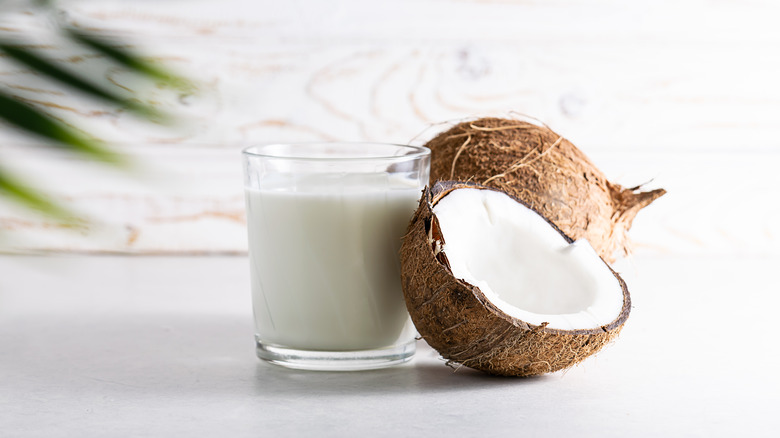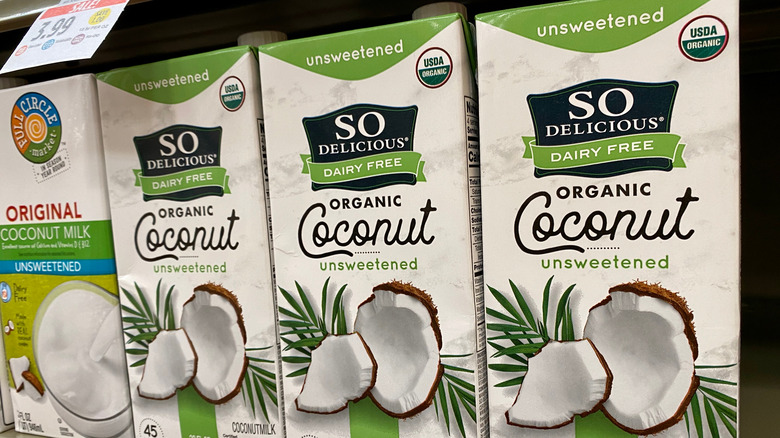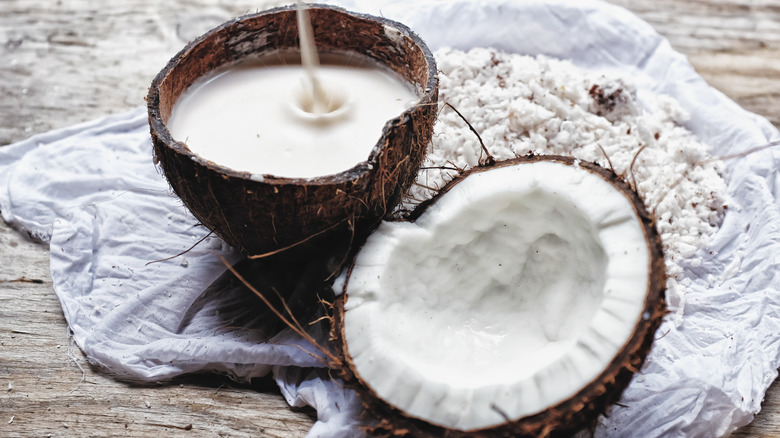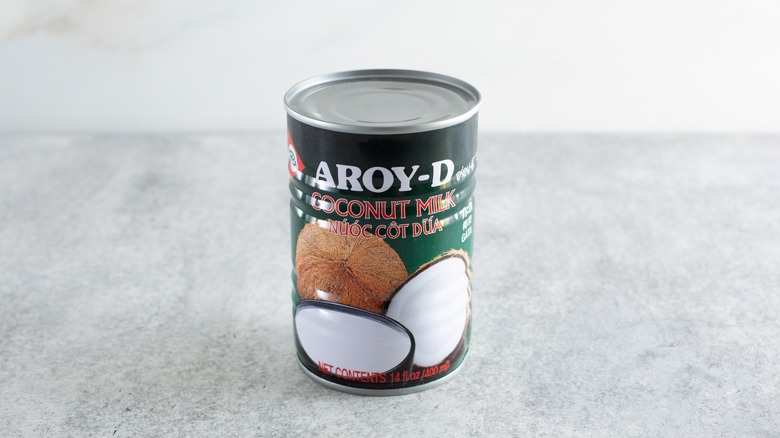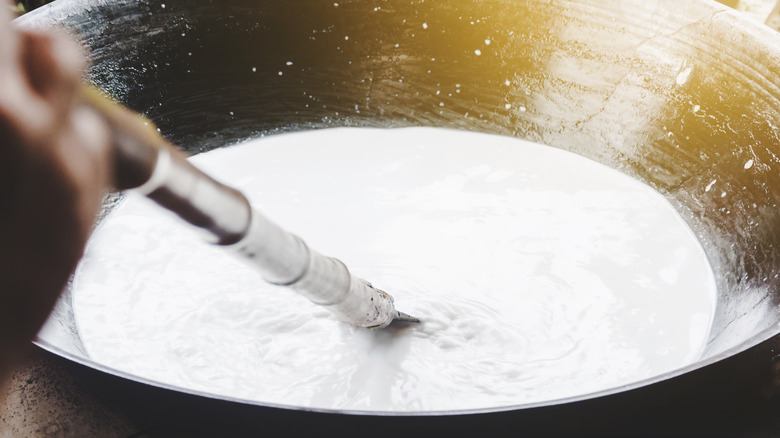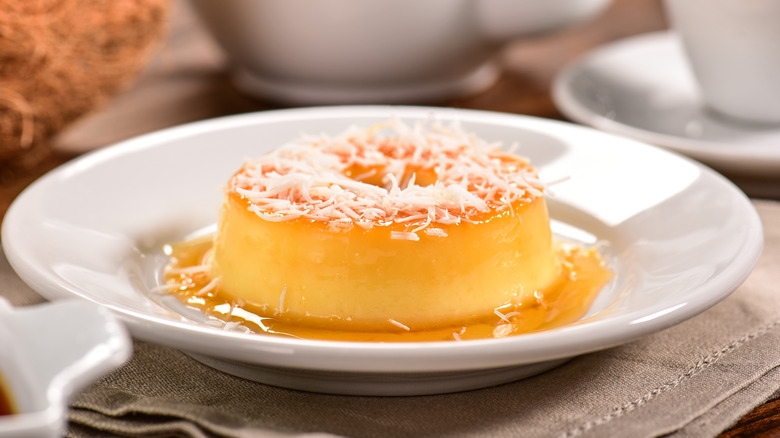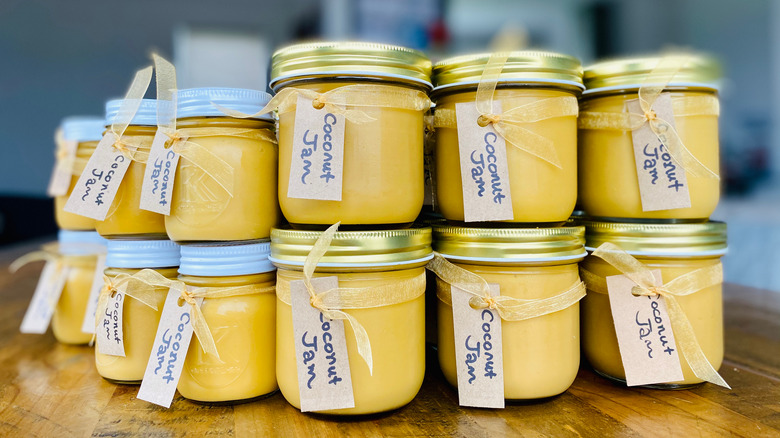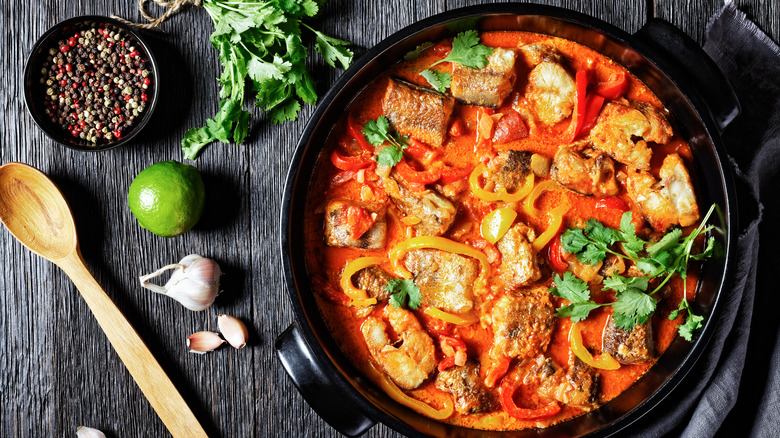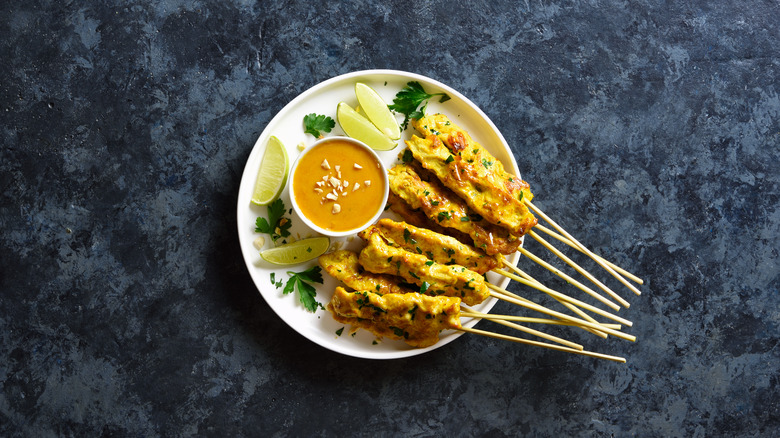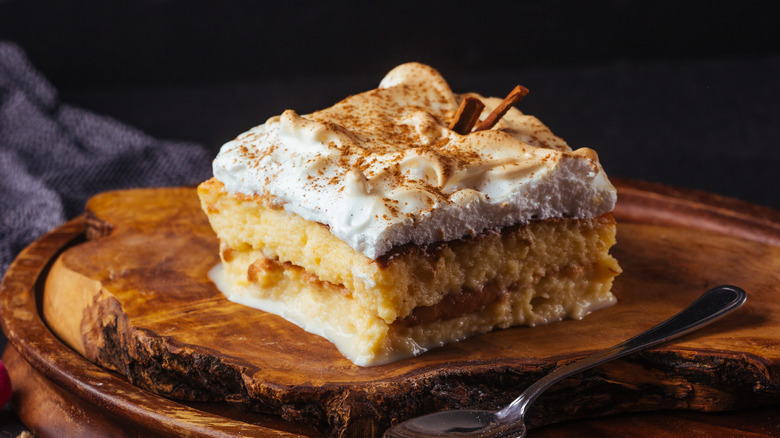Tips You Need When Cooking With Coconut Milk
Simply put, coconut milk is one of the most delicious and diverse ingredients in the world. Popular from Southeast Asia to India to Africa, coconut milk is packed with rich creaminess and natural sweetness. As a bonus, coconut milk is also a great dairy substitute, easily replacing it in many recipes.
So, what exactly is coconut milk? Not to be mistaken with coconut water (the liquid that occurs naturally inside the coconut), coconut milk is created from the meat of a mature coconut (via Eater). To extract the milk, a coconut is cracked opened, scraped, and shredded. The meat is then added to hot water to soften before it's finally squeezed to produce coconut milk.
Because coconut milk is so versatile, it's equally delicious in both savory and sweet recipes. As an ingredient used in countless cultures, there are essentially an endless number of potential recipes using it, ranging from spicy marinades to decadent desserts. To navigate this awesome ingredient, we've compiled the most helpful tips to aid your cooking adventures with coconut milk.
When to use sweetened vs unsweetened coconut milk
One of the first things to pay attention to when cooking with coconut milk is to make sure you're buying the right kind. Most commercially available coconut milk will be processed and homogenized for export. This means that many brands of coconut milk will often include ingredients like stabilizers and sweeteners (via Eater).
Because there's a huge variety of coconut milk brands and places of origin, figuring out the right coconut milk for your recipe can be tricky. To navigate this, a great starting point is determining if you need sweetened or unsweetened coconut milk. All coconut milk will have a natural sweetness regardless of added sweeteners. Generally, most coconut milk recipes, especially the savory ones, will call for unsweetened coconut milk (via Kitchn). However, Eater also recommends unsweetened coconut milk for dessert recipes. The reason? One word — flexibility. Sugar can always be added to unsweetened coconut milk, while the sweetened version has an already determined amount.
The difference between light, full-fat, and coconut cream
Besides sweetened and unsweetened, coconut milk can also be broken down into three separate categories: light (lite), full-fat, and coconut cream (via Kitchn). The difference between light and full-fat coconut milk is akin to the difference between nonfat and whole milk. Light coconut milk is coconut milk with most of the fat removed, leaving behind the pale, milky water. Eater doesn't recommend using light coconut milk, as it lacks much of the patented natural coconut flavor. As a rule of thumb, full-fat coconut milk is the preferred ingredient for most recipes.
Lastly, there's coconut cream. This coconut product is thicker than coconut milk, the result of being made with less water. This ingredient is best used for desserts like puddings and pies. Pro tip: When looking for coconut cream, be careful not to confuse it with another coconut cream product called "cream of coconut." Made by Coco Lopez, this Puerto Rican ingredient is very sweet and designed specifically for cocktails like piña coladas.
The fewer ingredients listed, the better
Unsurprisingly, the best kind of coconut milk will contain nothing but coconut and water, excluding added sugars and thickeners (via Eater). However, so many coconut milk brands in America make finding good quality coconut milk a conundrum.
One difficult part of judging coconut milk brands is trying to deduce how rich the product is from the description on the can. According to Eater, while most coconut milk brands don't typically disclose the ratio of coconut to water, a great way to determine the richness is to look at the listed fat and calories. Essentially, the higher the calories and fat, the richer the coconut milk.
For some chefs, there's another coconut milk product that's superior to cans — cartons. As Thai chef and cookbook author Pailin Chongchitnant explained to Eater, coconut milk in cartons is processed at higher heat for less time compared to cans, ensuring a superior flavor.
Shake or stir the can before using
When you first open a can of coconut milk, you'll notice two separate layers — a thick top layer with the consistency of cream, and a thin, pale white liquid underneath it. This top layer is the coconut cream, the source of the coconut's flavor and fat (via Eater). This fatty later of the coconut milk is also the ingredient used to make coconut oil. To make the oil, coconut cream is simmered until all the water is evaporated. The result? Pure, luscious coconut oil that's healthy and delicious.
To avoid this separation, shake the coconut milk can before you open it to mix the two layers (via Kitchn). Or, once the can has been opened, simply stir everything with a spoon to properly emulsify (some coconut milk brands will use ingredients like stabilizers to avoid this separation of the fat and water). Without this important step, it can be easy to accidentally use too much coconut cream or bland water for a dish, thus ruining the recipe.
Use coconut milk to replace dairy
As a dairy substitute, coconut milk is second to none. Not only is it deliciously creamy, but coconut milk cans are also shelf-stable (via Martha Stewart). And since it isn't a dairy product, individuals with dairy or lactose intolerances can also enjoy dishes with that rich creaminess thanks to coconut milk. While desserts like flan are a great choice, coconut milk is also an excellent creamer for coffee and can even be made into whipped cream, The Guardian explains.
Eater notes that coconut milk is often added to dishes in cuisines that use very little dairy (such as Thai cuisine) to inject richness and fat. Laura Page of Martha Stewart also recommends using coconut milk for dishes ranging from mashed sweet potatoes to creamed spinach. The natural nutty flavor of coconut milk will add a unique flavor dimension to these dishes, making them extra appealing.
It's great for savory or sweet recipes
One of the best things about coconut milk is its versatility. Simply put, coconut milk is one of those rare ingredients that's equally delicious in both savory and sweet recipes. Are you looking to add some richness to rice pilaf or need a dairy replacement for a flan recipe? Coconut milk is the answer.
The uses of coconut milk in savory preparations are endless. This is perfectly showcased by Food52, which uses the ingredient in recipes ranging from porridge to collard greens. But one especially popular dish for coconut milk is curry. A great deal of Southeast Asian curries, such as Northern Thai khao soi and Massaman curry, are heightened with the creamy richness of coconut milk (via Serious Eats).
In terms of desserts, coconut is peerless, something that's especially apparent in Southeast Asian cuisines. For instance, take sangkhaya, a sweet coconut custard that's eaten as a dip for white bread in Thailand. Because coconut milk is global, the diversity of desserts is immense, appearing everywhere from Latin American tres leches cake to kaya, a custard-like jam in Malaysia and Singapore.
Coconut milk is excellent with seafood
One preparation of coconut milk that's often overlooked is the ingredient's natural affinity to seafood. From stir fries to ceviche, coconut milk is used in a large variety of seafood recipes around the world. Many of these preparations, such as Thai tom kha (coconut shrimp soup), will include chilies (via Food52). Brazilian chef Natalia Pereira tells Eater that this fiery addition to seafood and coconut milk is a natural fit because "coconut milk can tolerate a lot of different spices and complexities of flavor, takes acid so well, and brings up the fruity nuances of everything it's involved with."
Serious Eats explains that besides hearty seafood preparations like curry and stews, coconut milk can also be used as a poaching liquid for fish. The cooking process for this is elegantly simple — just lightly simmer a fish filet in an herbaceous coconut milk broth for half an hour and enjoy the delicious results.
Use coconut milk for sauces, dips, and marinades
Coconut milk, while tantalizing cooked into stews or curries, is also phenomenal when incorporated in sauces, dips, and marinades. According to Serious Eats, their advice is to cook coconut milk with red curry paste until thick before adding lime, ginger, honey, and fish sauce for a fragrant dipping sauce. For a sweet sauce, they recommend mixing coconut milk with condensed milk and glazing it on some grilled pineapple.
A classic use of coconut milk is incorporating it into marinades. This technique is most common in Southeast Asian satays, grilled meat skewers derived from Middle Eastern kebabs (via Saveur). In Thailand, coconut milk is added to the marinade for muu satay (pork), giving the meat a natural sweetness. Besides pork, grilled beef is also a great pairing for a coconut milk marinade. A great example of this is the Lao Isan beef satay with coconut milk marinade from Hawker Fare by James Shayabut (via Food52). Filled with powerful herbs like lemongrass, garlic, and shallots, the coconut milk in this recipe is a perfect example of the ingredient's flexibility.
You can bake with it
If you're an avid baker, coconut milk is one ingredient you should always consider. As a dairy substitute, coconut milk can readily replicate milk and cream in countless types of baked goods. Or, it can also be combined with dairy to make classic baked desserts like coconut cream pie (via Martha Stewart). Because coconut milk is blessed with a distinct nutty flavor, any baked goods using coconut milk will benefit from this flavor infusion.
Of course, there are a lot more ways to use coconut milk in baking than coconut cream pie. Because coconut is more than just coconut milk, you can make cakes featuring all aspects of the fruit. A great example of this is the coconut key lime sheet cake from Epicurious, which features coconut milk, coconut oil, and shredded coconut meat. Pro tip: You can also use coconut milk to replace other dairy substitutes like almond milk in recipes.
How to store coconut milk
While it's true that an unopened can or carton of coconut milk can last several months, the tricky part is keeping leftover coconut milk fresh. MasterClass notes that fresh coconut milk generally only lasts a few days in the refrigerator, even if stored in an airtight container.
According to MasterClass, the best way to keep leftover coconut milk for longer periods of time is to freeze it. You can accomplish this by either pouring coconut milk into plastic freezer bags or ice cube trays (for easier servings). However, a big issue with frozen coconut milk is that the texture will morph, becoming grainy and losing some of the natural coconut flavors. But there is a way to solve this issue — an immersion blender (via Cook's Illustrated). As the frozen coconut milk blends, it will re-emulsify and taste nearly identical to a freshly opened can of coconut milk.
